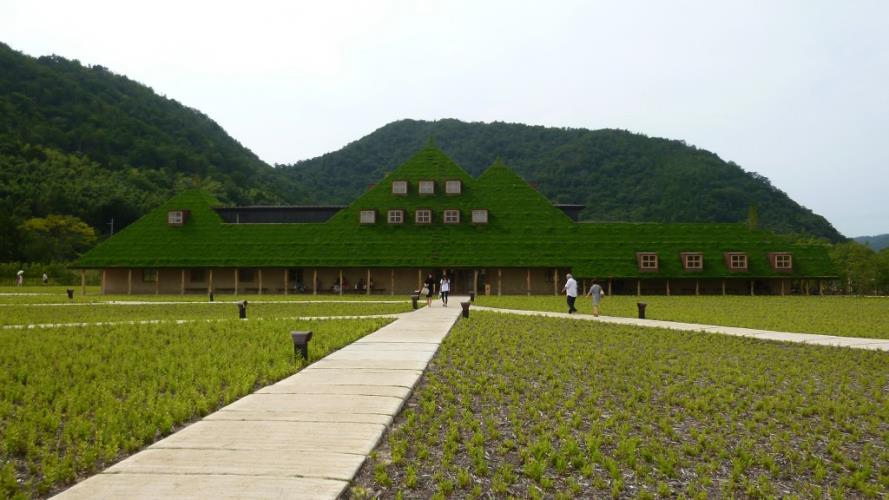Japan-based writer and traveller, specialising in design, lifestyle and travel journalism. Ron previously served as an editor of MING Magazine, ELLE Decoration and CREAM.

“Is that turf?” I exclaimed in delight when I saw the green roof in the distance. At first I was only thinking of wandering the streets of Hachiman-bori in the Shiga Prefecture, so I randomly picked up a map in the tourist information centre. I chose a point of interest which I did not have a clue what it was, and finally I arrived at a place where paddy fields greeted my eye. The paths amid the fields lead to a gigantic wooden house with a green roof. It looks like a lawn being pasted to the roof. Amid the turf is an array of windows, and the whole house resembles a cottage in a fairytale forest.
La Collina, run by wagashi (traditional Japanese confections) manufacturer Taneya, is a veritable candy house. The building was designed by Terunobu Fujimori, whose claim to fame is that he has designed a series of whimsical treehouses. The second floor of La Collina houses a café, while the ground floor is home to Taneya’s sweet shop and factory. You will see hardworking pastry chefs working in the kitchen and you will smell the aroma of cream and egg, while baumkuchen is churned out and sugarcoated. On the other side, you will see the making of dorayaki, with red bean paste filling between two pancake-like patties. Here, you are not only able to see the neat, pleasantly presented final product of wagashi, but also what it is made with and how to make it.
Taneya’s expection is to connect people, wagashi and the nature via La Collina. Through La Collina, you will understand how wagashi is made and how the ingredients – flour and rice etc. – are grown by peasant farmers with the blessings of the nature. Wagashi is beautiful, but its nature is pure and simple – it’s from the mother earth. The paddy fields surrounding La Collina are the farmland run by Taneya and managed by farmers and university students in Hachiman-bori. One of the farms is called Kitanoshou Garden and it grows different kinds of vegetables and fruits. Sometimes there are ducks waddling in the farms and this makes me think of the integrated rice-duck farming. But it’s not the case. Worms and birds play no role here. There only need to live there freely, and let visitors feel the harmony of living things coexist in the realm of nature. Further afield are rice fields owned by Taneya. Similar to Kitanoshou Garden, harvested crops are ingredients of wagashi.
The safety of imported food has become an alarming issue in Japan, and the influx of cheap food imports has undermined local producers. The idea of buying local produce has therefore gained a foothold in Japan. The JA National Federation of Agricultural Cooperative Associations’ direct sales channels cover the whole country and sell local produces in respective cities and towns. To promote the concept of buying local produces is also one of the reasons why Taneya operates La Collina. This is the only means to ensure that the food manufactured by them is safe. The construction and operation of La Collina have also responded to other problems now Japan is encountering. Take the forest industry as an example. Given the imbalance in wood demand and supply, a lot of forests lack management or even fall into disuse. Bamboo canes are one of the construction materials used when building La Collina, and they were harvested from an abandoned forest nearby. By doing so the forest was also given a chance to restore its ecosystems.
As a visitor, the highlight of La Collina is of course the candy house. But Taneya only sees it as one of the elements in their business. Equally important is “the art of farming” – agriculture is art and requires refined artistry. Cultivation is part of the art of farming, and education is an even more important part of it. In 2014, Taneya collaborated with Kyoto University and launched the Connectivity of Hills, Humans and Oceans Study Programme. The university was given resources and used the facilities in La Collina to carry out research on symbiosis in ecology. Focuses were given to the forests in Hachimanyama and Azuchiyama, old towns like Hachiman-bori and Biwako Lake.
Taneya’s outlets can be found all over Japan. Putting so many resources to education and research, they are highly praised for their willingness to shoulder corporate social responsibility. But Masahito Yamamoto, CEO of Taneya, explicitly said that he dislikes such words. He believes that contributing to the community is a matter of course, not a responsibility.